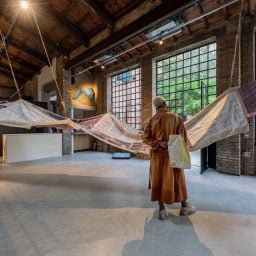“The Milk of Dreams,” the main show of the 2022 Venice Biennale, borrows its title from the children’s book by Surrealist painter Leonora Carrington (1917–2011), suggesting a mode of thinking that normalizes the otherworldly. It’s a timely exhibition, out to promote images of new worlds as communities worldwide explore strategies for resilience and economic revival.
Curator Cecilia Alemani’s main show includes over 200 artists from 58 countries. More than 180 of these artists have never participated in the international art exhibition before today. While the last Biennale in 2019 had gender parity, this year it exhibits an overwhelming majority of female and gender non-conforming artistic practitioners. Still, while the exhibition’s lens is inclusive in terms of gender, there is a narrower selection of Black and African diaspora artists across the Arsenale and Giardini spaces of the main show, accounting for around 30 of the included artists, by my count.
As for the national pavilions, they include 80 at the Giardini, the Arsenale, and in the City Center. This year welcomed the inaugural participation of the Republic of Cameroon, Namibia, and Uganda, as well as returning participation from Ghana, South Africa, and Zimbabwe. In this mass exhibition of dreams, pavilions fight it out for fame in locations either central or literally on the edge of sight. For some, the dynamics of the Biennale’s international convening viscerally expose that there is no level playing field when it comes to global competition—in art or more generally.
The task I set myself was to look at how Africa and its diaspora was visualized in Venice. In the selection of artists examined below, drawn from across the pavilions of the U.K., U.S.A., and Belgium, as well as from “The Milk of Dreams,” artists explore the brutality, beauty, and metamorphoses of the Black imaginary through depictions of inner lives, the past, or times yet to come. The emancipatory escape into other worlds becomes a tool as we fight for our place in this world.
Tourmaline
“The Milk of Dreams”
![Tourmaline, <em>Mary of Ill Fame</em> [film still] (2020-21).](https://news.artnet.com/app/news-upload/2022/05/Tourmaline-mary-of-ill-fame-3-1024x540.jpg)
Tourmaline, Mary of Ill Fame [film still] (2020-21).
(2020-2011) is the activist, writer, and filmmaker Tourmaline’s cinematic challenge to state-sponsored transphobic violence and the racialized incarceration that brutalises and stigmatises queer ethnic minorities. It serves up a 25-minute speculative story of Mary Jones, a real-life Black trans sex worker and outlaw, who was tried in 1836 with grand larceny for allegedly stealing a white man’s wallet. It is a sumptuously scripted historical tale that embodies American scholar Saidiya Hartman’s approach to re-reading the past, known as “critical fabulation.”
In “The Milk of Dreams,” Mary of Ill Fame is presented through a three-channel film installation in a catacomb-like theatre. Tourmaline dials time back to a free Black community of landowners in Seneca Village, upper Manhattan, destroyed in 1855 to make way for Central Park.
![Tourmaline, <em>Mary of Ill Fame</em> [film still] (2020-21).](https://news.artnet.com/app/news-upload/2022/05/tourmaline-mary-of-ill-fame-6-1024x540.jpg)
Tourmaline, Mary of Ill Fame [film still] (2020-21).
The high-octane work (produced by Keanu Reeves) makes use of visual codes and sassy quips cited from blacksploitation drama, serving satire, defiance, and self-actualisation through imagery of witch trials of Black individuals, dreamscapes, and nightmarish scenes that function as similes for today’s gentrification and the fight for Black space in a changing New York City.
The story gives a sense of the intricacies of queer-hetero connections as sites of both constriction and camaraderie, though ultimately it visualizes the unending struggle between white men fixed on asserting their authority and all those who find their backs against the wall.
Simnikiwe Buhlungu
“The Milk of Dreams”
And the Other Thing I Was Saying Was: A Conver-Something (2022) assembles a family of theremins (analogue electronic synthesisers), placed in a crypt-like cave, for an installation exploring how dreams are produced. For Buhlungu, theremins are significant symbols, because they are silent objects that come alive by human activation, generating music from our bodies’ electromagnetic fields. Instructions direct the viewer or listener to stand close, activating the instruments, but instead of the theremins’ eerie noise, they trigger recordings of the voices of historical figures who dared to dream, notably the South African singer Miriam Makeba.
Other soundscapes activated by the theremins summon high-pitched cries of Hadeda birds, linguistic articulations that are foreign to Western ears, or what are described as “interstitial noises excerpted from Kenyan author Binyavanga Wainaina’s 2015 Ted Talk,” in which the late Kenyan author and gay rights activist struggles with his choice to hide his sexuality from his late father.
Ali Cherri
“The Milk of Dreams”
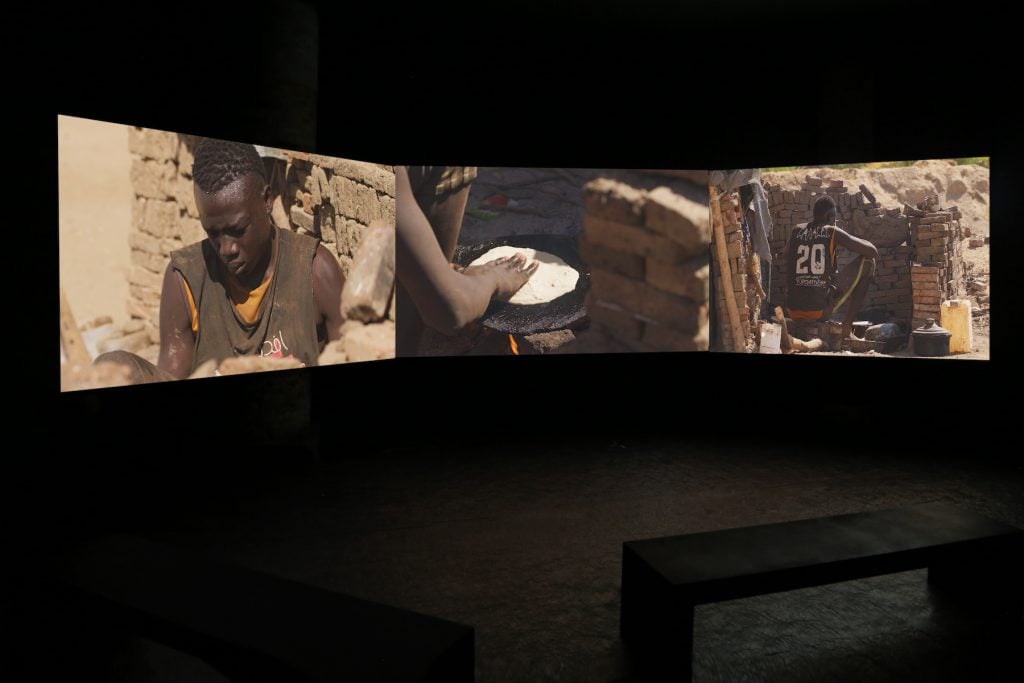
Installation view of Ali Cherri, Of Men and Gods and Mud (2022). Photo © Ali Cherri.
A Lebanese artist working across film, video, installation, and drawing, Cherri’s new multi-channel video installation Of Men and Gods and Mud (2022) takes as its subject the history of one of the largest hydroelectric dams in Africa, the Merowe Dam, a highly controversial construction on the Nile in northern Sudan that led to rampant social unrest. The building in the early 2000s led to the displacement of more than 50,000 people and the relocation of families forced from their riverside lands into the inhospitable Nubian desert.
“Somewhere by the banks of a great river, in the shadow of a gargantuan dam, a man stands waist-deep in mud,” a narrator intones as we watch a seasonal brickmaker spend his days in the heat performing the arduous, ancient task of shaping mud into bricks. The audience is seduced by the trance-like visions of a greenfield site where Black men work in unison. What could be regarded as images of toil and drudgery are here reframed as the new construction work after an imaginary deluge. The brickmaker’s work becomes a generative act, bearing optimism for the future development of Africa. Radical change is made possible by participating in the production of a new world.
Simone Leigh
U.S National Pavilion
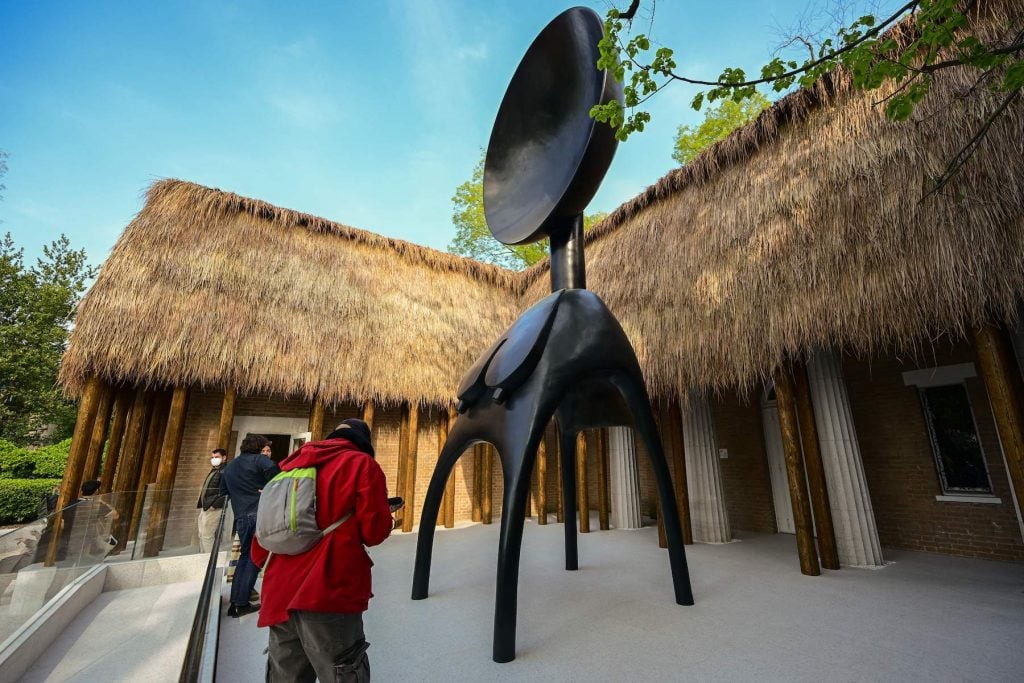
Visitors view Satellite, part of US artist Simone Leigh’s Venice exhibition entitled “Sovereignty,” during a press day at the 59th Venice Art Biennale in Venice on April 20, 2022. (Photo by Vincenzo Pinto/AFP via Getty Images)
“Sovereignty,” Simone Leigh’s eagerly anticipated U.S. Pavilion, has a thatched roofing facade resembling a 1930s West African palace. The structure thus draws upon the 1931 Paris Colonial Exposition, which included the full-scale remodeling of the Khmer temple Angkor Wat as well as model villages and towns for the exhibition that normalized the “human zoo”: the display of cultures, lands, and people seized under colonial empire. Instead of re-enacting colonialist constructions that continue to spread to all corners of the world, within, through stellar bronze cast work, Leigh creates a group of power objects that contest inherited images of Black femme subjectivity.
For Leigh, women are excavators and authors of their own history and knowledge, and she creates a new hybrid art that can at once serve as self-affirmation and reflect on African heritage and economies in the New World. The artist’s new body of large-scale sculptural works stretch the possibilities of clay, urging Black women, and other under-documented groups that nurture societies in silence, to, in her own words, “concern yourself with issues of scale.” The Last Garment embodies the washerwoman at work, while The Sentinel combines an elongated nude female form with a mystic object that traditionally finds its place in fertility rituals.
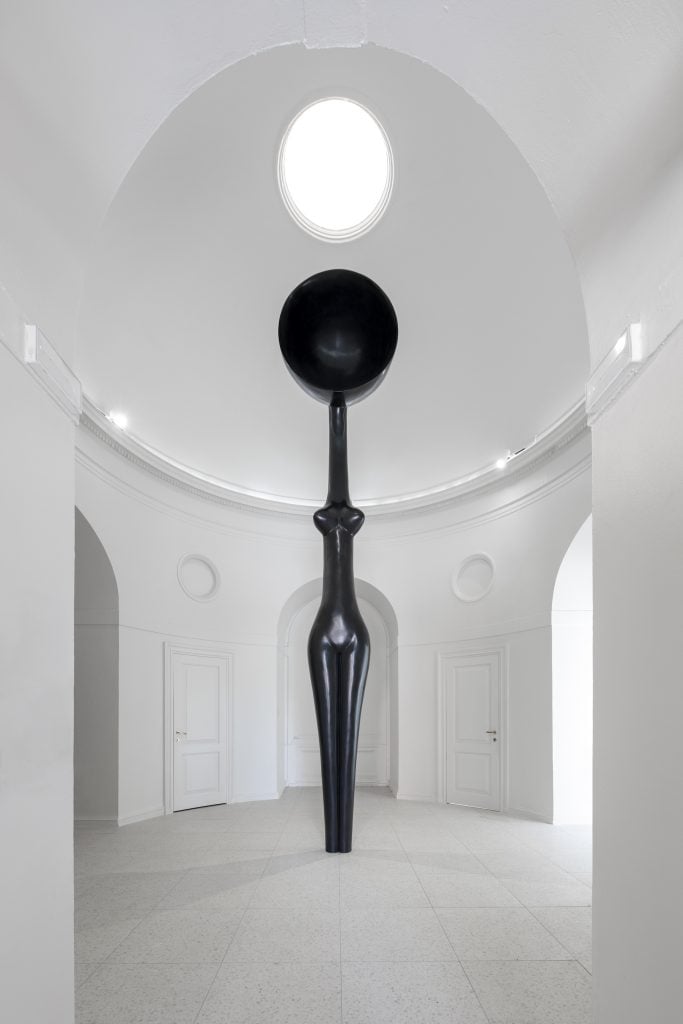
Simone Leigh, Sentinel (2022). Courtesy the artist and Matthew Marks Gallery. Photo by Timothy Schenck. © Simone Leigh
The Sentinel’s faceless, imposing marvel adds to the overall ability of Leigh’s “Sovereignty” to open up imaginative possibilities beyond manufactured myths that shrink, limit, or define Black women’s interior and exterior worlds, constricting them to roles as workers, mothers, or objects of desire.
Francis Alÿs
Belgium National Pavilion
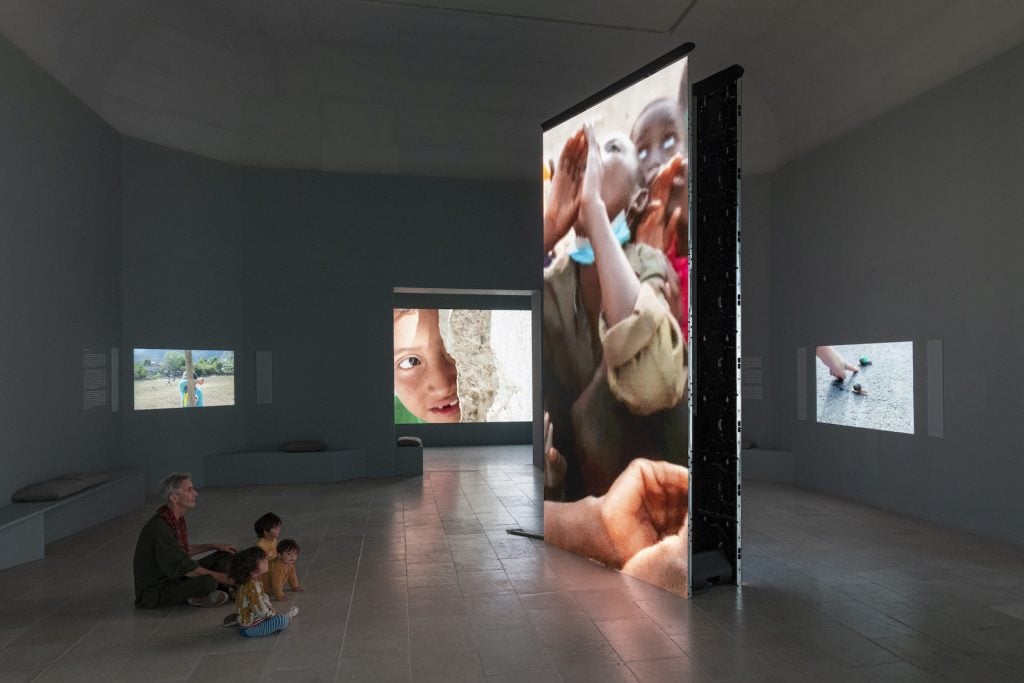
“The Nature of the Game,”
Francis Alÿs’s pavilion for Belgium at the 2022 Venice Biennale. Credit: Roberto Ruiz.
In a series of documentary-style installations, The Nature of the Game investigates the repercussions of children’s games during the Covid-19 pandemic in cities such as Tabacongo and Lubumbashi in Democratic Republic of Congo, as well as in other countries including Belgium, Mexico, and beyond.
The dimly lit pavilion invites visitors to navigate their way through a labyrinth of screens, each showing scenes where children play with each other, kicking aluminum cans or passing time trading stones, each in their respective environments, each respecting their own rules of game playing. In one video from the DRC, where mosquitoes carry malaria, children are seen summoning the insects through a high-pitched whistle to cull the insects.
As local variants of coronavirus thrived and the young and unruly overlooked official distancing measures, even a simple exchange such as playing Kisolo, a board game played on the street, became a way to transfer risk. Returning to his penchant for an ethnographic approach to surveying human interactions, Alÿs contribution celebrates the lack of inhibitions among the young while illuminating the fear of contagion that continues to afflict the population more generally.
Sonia Boyce
U.K. National Pavilion
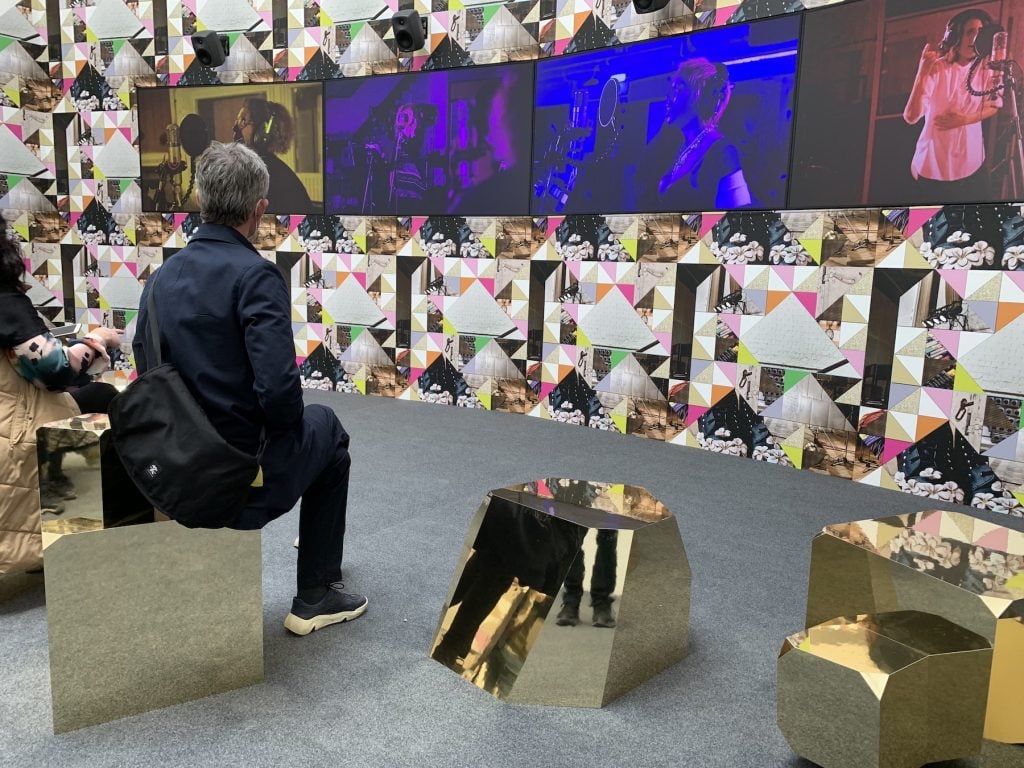
Visitors watch Sonia Boyce’s 2022 Venice Biennale show. Photo by Andrew Goldstein.
Boyce’s Feeling Her Way envelopes the visitor in a harmonious assault of sound, where five female musicians, many of whom within this work are strategically described as Black women—a racial term which could use unpacking further–improvise, undulate, and beauteously wail in a call and response to each other. The aural environment is captivating, offering a tranquil haven through song, and a multi-channel film journey showing the possibilities that open up with the removal of inhibitions.
Yet, despite its win as Best Pavilion, I wouldn’t say the work lives up to expectations. While the sound is entrancing, on a visual level, Boyce’s pavilion is unappealing and marked by a flurry of bad taste in imagery, meant to evoke the kind of music memorabilia you’d expect to see on a teenager’s bedroom walls. In fact, Boyce seems to know that this will not be to all tastes: Using a symbol she has returned to before, gilded geometric forms set into the walls and floor are meant to suggest the mineral Pyrite, better known as ‘fool’s good’, a term that relegates it symbolically to the status of ‘other.’ It “raises question,” a text explains, “about judging by comparison,” undercutting in advance any critic who measures Boyce’s under-delivery through negative comparison, since, of course, beauty is in the eye of the beholder.
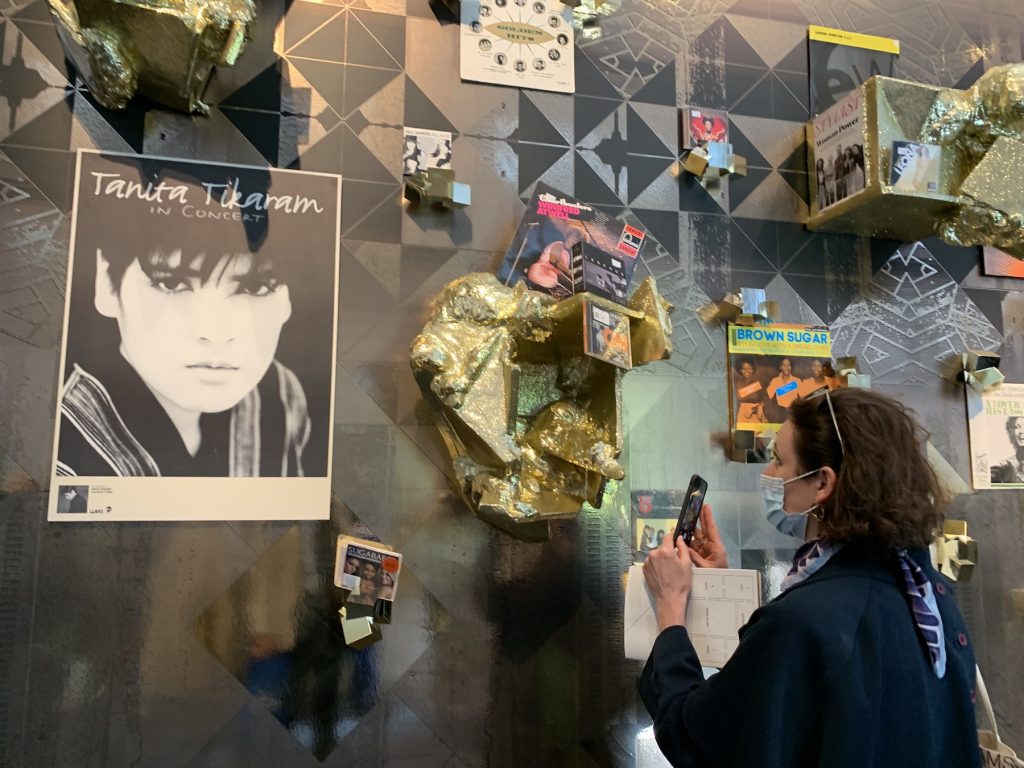
Display inside Sonia Boyce’s pavilion for the U.K. at the Venice Biennale. Photo by Ben Davis.
Boyce’s career has progressed without sufficient national, let alone international, acknowledgement; thus, the opportunity of the 2022 Biennale to present and compete on a global scale sparked hope for something truly extraordinary. But Boyce’s mélange of “Black voices” doesn’t necessarily represent anything in common besides a shared musical space. It feels as though she is removing herself from racial discourse beyond a merely baseline representational sense, a gesture which feels guarded despite also pointing to a weight many seek to shed. It leaves audiences within a Black diaspora longing for a stronger statement. As for the physical installation itself, Boyce’s conceptual focus starves the community of the experiential richness that it deserves.
![Tourmaline, Mary of Ill Fame [film still] (2020-21). Courtesy of the artist and Chapter NY, New York. Tourmaline, Mary of Ill Fame [film still] (2020-21). Courtesy of the artist and Chapter NY, New York.](https://news.artnet.com/app/news-upload/2022/05/tourmaline-mary-of-ill-fame-5-1024x540.jpg)

![Tourmaline, <em>Mary of Ill Fame</em> [film still] (2020-21).](https://news.artnet.com/app/news-upload/2022/05/Tourmaline-mary-of-ill-fame-3-1024x540.jpg)
![Tourmaline, <em>Mary of Ill Fame</em> [film still] (2020-21).](https://news.artnet.com/app/news-upload/2022/05/tourmaline-mary-of-ill-fame-6-1024x540.jpg)







